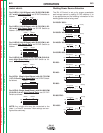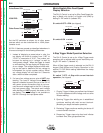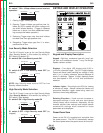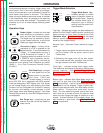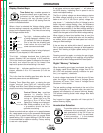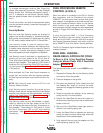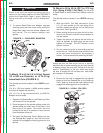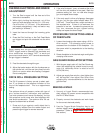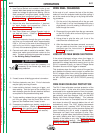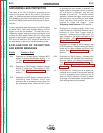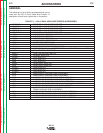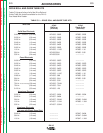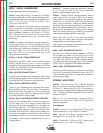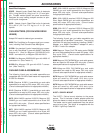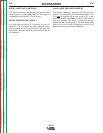
Return to Section TOC Return to Section TOC Return to Section TOC Return to Section TOC
Return to Master TOC Return to Master TOC Return to Master TOC Return to Master TOC
B-11
OPERATION
B-11
4. Use Control Select and encoder knobs to set
desired Weld feed speed and voltage then Run-in
speed and voltage to optimize arc starting. (Set for
each procedure if using front panel, remote control
or optional dual procedure switch.) (Refer to
Operation Keys
and
Display Control Keys
in this
section.)
5. Adjust the wire feed acceleration, if desired,
for each feeder and procedure. (Refer to
Acceleration Selection
in this section.)
6. Use Timer Select and Voltage Encoder knob to
set desired timers. (Refer to
Trigger Mode
Selection
in this section.)
7. Feed the electrode through the gun and cable
and then cut the electrode within approximately
0.38 in. (9.5 mm) of the end of the contact tip for
solid wire and within approximately 0.75 in.
(19 mm) of the extension guide for cored wire.
8. Connect work cable to metal to be welded. Work
cable must make good electrical contact to the
work. The work must also be grounded as stated
in
Arc Welding Safety Precautions
.
9. If used, be sure shielding gas valve is turned on.
10. Position electrode over joint. End of electrode
may be lightly touching the work.
11. Lower welding helmet, close gun trigger, and
start welding. Hold the gun so the contact tip to
work distance gives the correct electrical stickout
as required for the procedure being used.
12. To stop welding, release the gun trigger and then
pull the gun away from the work after the arc
goes out and Postflow time, if used, is over.
13. If necessary to optimize arc starting, readjust wire
speed acceleration, (Refer to
Acceleration
Selection
in this section) and/or Run-In speed,
(Refer to
Display Control Keys
in this section).
DH-10
When using an Open Arc process, it is
necessary to use correct eye, head, and
body protection.
____________________________________
WARNING
WIRE REEL CHANGING
At the end of a coil, remove the last of the old elec-
trode coil from the conductor cable by either pulling it
out at the nozzle end of the gun or by using the follow-
ing procedure:
1. Cut the end of the electrode off at the gun end.
Do not break it off by hand because this puts a
slight bend in the wire making it difficult to pull it
back through the nozzle.
2. Disconnect the gun cable from the gun connector
on the DH-10 wire drive unit and lay the gun and
cable out straight.
3. Using pliers to grip the wire, pull it out of the
cable from the connector end.
4. After the electrode has been removed, reconnect
the gun cable to the drive. Load a new reel of
electrode per the instructions in
Wire Reel
Loading
in this section.
LOSS OF VOLTAGE SENSE SHUTDOWN
If the actual displayed voltage, when the trigger is
closed, drops below 8.0 volts for over 0.8 second it is
assumed the voltage feed back sensing circuit to the
DH-10 is opened or faulty, so Loss of Voltage Sense
Shutdown occurs until the trigger is released.
This shutdown stops the motor, shuts off the gas flow
and disables the power source output to prevent the
DH-10 voltage control from driving the power source
output too high due to loss of proper feedback sensing
via #21 (WORK) and #67 (ELECTRODE) sensing
leads.
WIRE FEED OVERLOAD PROTECTION
The DH-10 has solid-state overload protection of the
wire drive motor. If the wire drive motor becomes
overloaded for an extended period of time, the protec-
tion circuitry turns off the power source, wire feed and
gas solenoid, and then displays “H30” on the WFS
display (with blank Voltage display). This indicates
the wire drive motor is overloaded and will remain
shut down for about 30 seconds before the unit will
automatically reset. The “H30” display decrements
every second until it reaches “H00”. At that time, the
unit resets automatically and the previous displays will
return indicating the unit is ready to operate again.
Overloads can result from improper tip size, liner,
drive rolls, or guide tubes, obstructions or bends in the
gun cable, feeding wire that is larger than the rated
capacity of the feeder or any other factors that would
impede normal wire feeding. (See
Avoiding Wire
Feeding Problems
in the
Maintenance
section).



